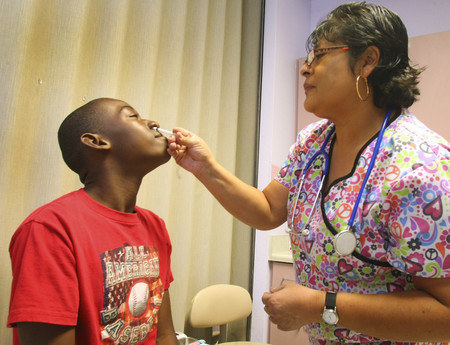Health officials wonder about outreach
Unless you live under a rock, it's difficult to miss that an H1N1 flu outbreak is under way in Southern Nevada.
Newspapers, TV, radio, the Internet, billboards, ads on buses and in movie theaters. They all pass on the message of public health officials practically every day: If you're in a high-risk group and get a swine flu shot, you have protection from a virus responsible for around 20,000 hospitalizations nationwide and more than 1,000 deaths.
Also passed on to the public is information about where people can receive either a free or a low-cost vaccination.
And still, the Southern Nevada Health District has tens of thousands of doses of vaccine on hand.
Dr. Tracey Green, the state's chief health officer, will speak today with health district officials and other public health administrators around the state to determine whether there has been sufficient outreach in making the vaccine available to the five at-risk groups: pregnant women; caregivers for children younger than 6 months; health care and emergency personnel; those between 6 months and 24 years of age; and adults up to 64 with chronic health conditions.
If Green and Richard Whitley, administrator of the Nevada State Health Division, determine that every effort has been made to target the priority groups, the vaccine will be made available to all Nevadans.
"Just because we have vaccine sitting on the shelf does not necessarily mean we've done an excellent job of trying to saturate the priority groups," Green said.
Stephanie Bethel, a health district spokeswoman, said 147,000 doses of vaccine, both the inhaled and the injectable versions, were received by the district since deliveries began in October.
About 71,000 people have been vaccinated. As of Monday, the district had 60,000 doses on hand; some doses have been distributed to private providers.
The district has received $6.7 million from the federal government for the vaccination program, which includes operating and staff clinics. About $1.2 million has been spent, Bethel said.
Local officials only recently began vaccinating people 25 to 64 with chronic health conditions. Earlier, they said they did not want to use all of the vaccine the district had on hand for fear that one day it would run out during a clinic.
Green said she is particularly interested in how local public health officials have worked to ensure that as many schoolchildren as possible receive the vaccine.
"Kids from elementary school up through college are really hit hard by this virus," she said. "This virus is different."
Statistics from the federal Centers for Disease Control and Statistics show that Americans up to age 24 are about 20 times more likely to contract the virus than people older than 65, the group which the seasonal flu usually hits the hardest.
In the eight months since the H1N1 pandemic began, 114 children in the United States have died from swine flu, already above the 88 who died during the entire 2007-08 seasonal flu season.
Kay Godby, a senior public health planner with the health district, said the agency worked with Clark County School District officials to develop a strategy to get as many vaccines as possible to children.
That plan, she said, largely consisted of putting on weekend clinics at high schools. Parents of students at middle schools and elementary schools were advised through notes sent home with their children where clinics would be held.
"The school district felt at first that it would be better not to disrupt children during the school day," said Jennifer Sizemore, a health district spokeswoman.
By the end of this weekend, clinics will have been held at seven high schools. Sizemore said the longer the vaccination program goes on, the smaller the crowds are.
"Those who really want it get it at first," she said.
Dr. Noah Kohn, medical director of Clinics in Schools, a program that largely works with low-income students, is taking the vaccine directly into the schools.
More than 400 students at Basic High School in Henderson received vaccinations Tuesday. Two elementary schools, Martinez and Cunningham, are also participating.
Kohn's program, which receives vaccine through state channels, eventually will go to 15 schools.
Sizemore said the school district now appears interested in health district personnel going directly into schools.
"Our problem," Sizemore said, "is that the Clark County School District has more than 300 schools. That's why it seemed better to have an area school on weekends for parents to take their children to."
The health district has planned vaccination days at two College of Southern Nevada campuses before Christmas.
Students at the Charleston campus can get vaccinated on Dec. 9 and students at the Cheyenne campus the following day.
Officials at Nevada State College said they had "moderate interest " in vaccinations and received only 200 doses of vaccine.
The University of Nevada, Las Vegas student health center, which runs independently of the health district, started giving H1N1 vaccine in mid-November.
It received an initial shipment of 200 doses from the health district and then an additional 100 doses. Earlier this week, 500 doses were received.
"We exhausted all of the 300 doses received prior to this week, save a few injectable doses held back for high-risk populations," spokesman Dave Tonelli said in an e-mail. Another clinic will be held Thursday, with the school following federal guidelines as to who gets the vaccine.
Nursery schools and day care centers are scheduled to have vaccinations done by a health district "strike team," which usually consists of two nurses and a clerk.
The 10 largest have been targeted by public health officials, Godby said.
Sizemore said that although there still is public interest in vaccinations -- she said about 1,500 people get vaccinated daily at the district's main campus on Shadow Lane -- district officials think it's time to open the program up to everybody.
"We want as many people who want it to get it," she said.
Contact reporter Paul Harasim at pharasim@reviewjournal.com or 702-387-2908.




























